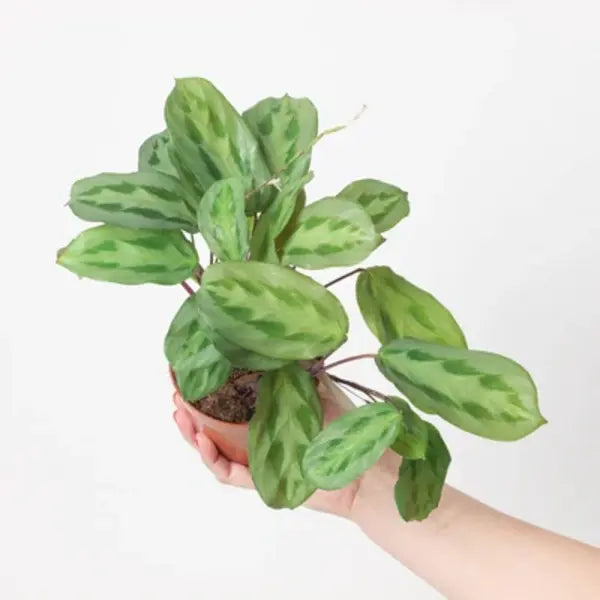
Maranta Cristata
Selling size : Third Image | Single Plant | Secure Packing | Pot included
The Maranta Cristata, often called the Rabbit's Foot Prayer Plant, is a popular houseplant known for its distinctive patterned leaves that fold up at night.
Here's a comprehensive care guide for maranta:
1. Light:
Bright, Indirect Light is Key: This plant loves bright, indirect light. Think of its natural habitat on the rainforest floor, where it receives dappled sunlight through the tree canopy.
Avoid Direct Sun: Direct sunlight will scorch its delicate leaves, causing them to fade, turn yellow, or develop brown blotches.
Tolerates Lower Light: While it prefers bright indirect light, it can tolerate lower light conditions, but its vibrant patterns might become less pronounced, and it might get leggy.
Ideal Placement: An east or north-facing window is often ideal. If you have a south or west-facing window, place it a few feet away or use sheer curtains to filter the light.
Rotate Regularly: Rotate your plant every few weeks to ensure all sides receive even light exposure, promoting balanced growth.
2. Watering:
Consistently Moist, Not Soggy: The Maranta prefers to be kept consistently moist but never waterlogged. Overwatering can lead to root rot.
Check Soil Moisture: Water when the top 1-2 inches of soil feel dry to the touch. Avoid letting the soil completely dry out.
Use Room Temperature, Filtered Water: Maranta plants are sensitive to chemicals like chlorine and fluoride found in hard tap water, which can cause brown leaf tips. Use filtered, distilled, or rainwater. If using tap water, let it sit out overnight to allow some of the chemicals to dissipate.
Thorough Watering: When you water, do so slowly and evenly until water drains from the bottom of the pot. Ensure no stagnant water sits in the saucer.
Reduce in Winter: During the winter months, when growth slows, you can reduce watering slightly.
3. Humidity:
High Humidity is Essential: These tropical plants thrive in high humidity (around 60-80%), mimicking their native rainforest environment. Low humidity is a common cause of brown, crispy leaf tips.
Ways to Increase Humidity:
Misting: Mist the leaves regularly (daily or every couple of days) with filtered or distilled water. Avoid over-wetting the leaves, as this can lead to fungal issues.
Pebble Tray: Place the pot on a tray filled with pebbles and a shallow layer of water. Ensure the bottom of the pot isn't sitting directly in the water.
Humidifier: Using a room humidifier is the most effective way to maintain consistent high humidity.
Group Plants: Grouping plants together can create a mini-microclimate of higher humidity.
Bathroom/Kitchen: A naturally steamy bathroom or kitchen can be an excellent spot for them.
4. Temperature:
Warm and Stable: Maranta Leuconeura 'Kerchoveana' prefers average to warm temperatures between 18°C to 27°C (65°F to 80°F).
Avoid Cold Drafts: Keep them away from cold drafts, air conditioning vents, and heating vents, as sudden temperature changes can stress the plant and cause leaves to curl. Do not let temperatures drop below 15°C (60°F).
5. Soil:
Well-Draining and Rich: Use a well-draining, rich potting mix that retains some moisture but doesn't become waterlogged.
Slightly Acidic: They prefer a slightly acidic soil pH. A mix of peat, perlite, and compost works well.
6. Fertilization:
During Growing Season: Fertilize every 2-4 weeks during the growing season (spring and summer) with a balanced, water-soluble houseplant fertilizer diluted to half the recommended strength.
Reduce in Winter: Reduce fertilization to about once a month or stop entirely during the fall and winter when growth slows.
7. Repotting:
Every 1-2 Years: Repot your Maranta every 1-2 years in the spring, or when it becomes root-bound.
Slightly Larger Pot: Choose a pot that is only 1-2 inches larger in diameter than the current one. They prefer wider, shallower pots to accommodate their rhizomatous root system.
Drainage: Always use a pot with drainage holes. You can add a layer of gravel or clay balls at the bottom for improved drainage.
8. Pruning:
Encourage Bushiness: Prune back any yellow, damaged, or leggy stems to encourage bushier growth and maintain a compact shape. You can prune two or three times a year, ideally in spring and fall.
9. Common Problems and Solutions:
Brown, Crispy Leaf Tips: Usually a sign of low humidity or salt/mineral buildup from hard tap water. Increase humidity and use filtered water.
Yellowing Leaves: Can indicate overwatering (soil too wet) or underwatering (soil too dry), or sometimes a nutrient deficiency. Adjust watering schedule.
Curling Leaves: Often a sign of underwatering or low humidity.
Washed Out Color/Brown Blotches: Too much direct sunlight. Move to a shadier spot.
Leggy Growth: Not enough light. Move to a brighter location.
Pests: Prayer plants can be susceptible to spider mites (especially in low humidity) and mealybugs. Inspect regularly and treat with insecticidal soap or neem oil if necessary. Increasing humidity helps deter spider mites.
Root Rot: Caused by overwatering and poor drainage. If the soil smells musty and roots are mushy, repot with fresh, well-draining soil after trimming any affected roots.
By following these care tips, your Maranta Cristata should thrive and continue to display its beautiful "praying" leaf movements!

